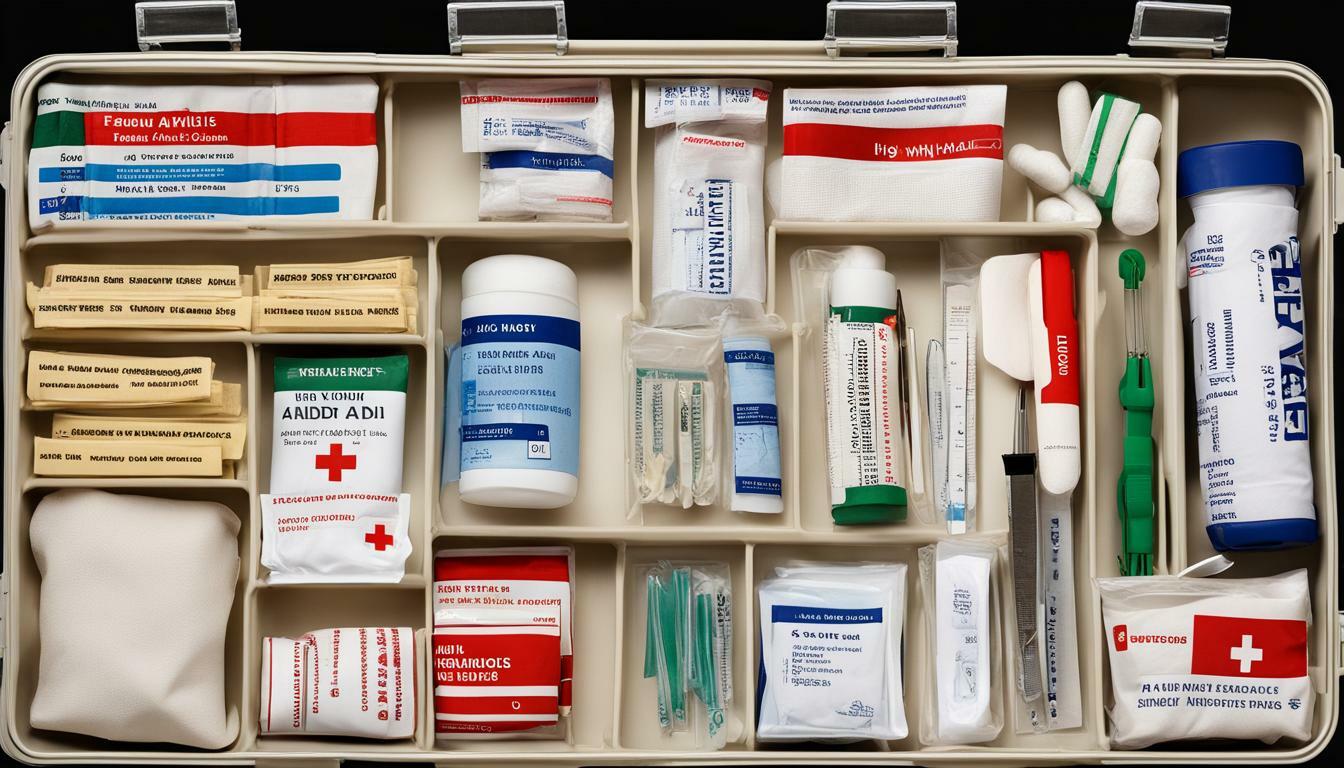Welcome to our comprehensive guide on first aid kit organisation and storage. As anyone who has ever experienced an emergency knows, having a well-stocked and properly organised first aid kit can make all the difference in a crisis situation. In this guide, we will provide you with all the information you need to create an effective first aid kit, tailored to your specific needs and lifestyle. From choosing the right container to labelling items and stocking up on essentials, we’ve got you covered.
Whether you’re a first-time kit owner or a seasoned pro, our guide will provide you with valuable tips and tricks to ensure that you’re always prepared for any emergency.
Key Takeaways:
- Proper organization and storage of a first aid kit is essential for emergency preparedness.
- Assess your specific needs to tailor your kit to your lifestyle and potential risks.
- Choosing the right container and organizing the contents of your kit can make all the difference in an emergency.
- Regularly review and update your kit to ensure that it remains well-stocked and up-to-date with the latest supplies and information.
Understanding the First Aid Kit
Before diving into the details of organizing and storing a first aid kit, it’s crucial to understand the contents of such a kit.
A first aid kit typically includes a variety of essential items for treating minor injuries and illnesses. These can range from adhesive bandages and antiseptic wipes to gauze pads and medical tape. Other common items found in a first aid kit include scissors, tweezers, and a thermometer.
While it’s important to have all of the necessary supplies on hand, it’s also important to note that the contents of a first aid kit may vary depending on your specific needs. For example, if you have allergies, it may be important to include an EpiPen. If you have a history of heart problems, it may be necessary to include aspirin in your kit.
Here are some essential first aid supplies that should be included in any kit:
- Adhesive bandages: These are commonly known as Band-Aids and are used to cover small cuts and scrapes.
- Gauze pads: These are used for more significant wounds and can be used to help stop bleeding.
- Medical tape: This is used to secure dressings and bandages in place.
- Antiseptic wipes: These are used to clean wounds before they are bandaged.
- Tweezers: These can be used to remove splinters or other foreign objects from the skin.
- Scissors: These can be used to cut tape, gauze, or clothing away from an injured area.
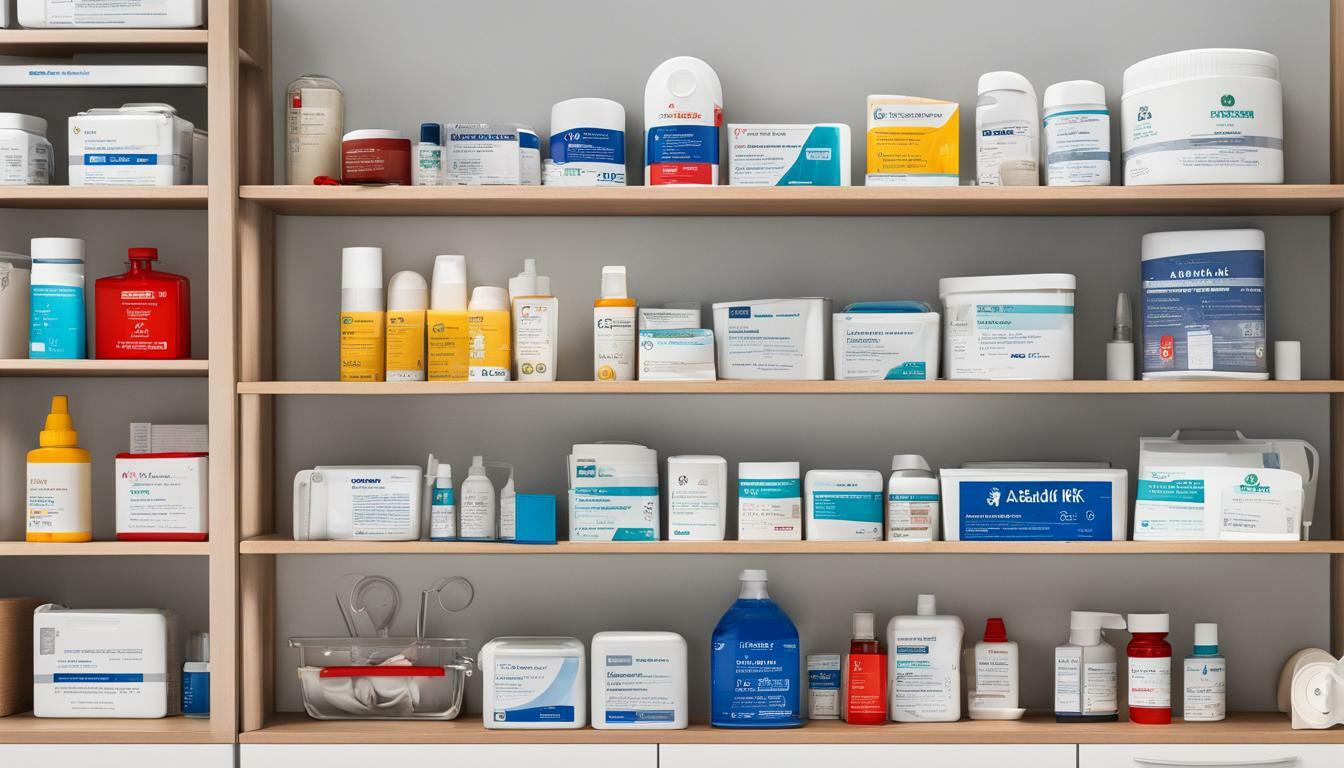
It’s important to note that while first aid kits are essential for home safety and emergency preparedness, they are not a substitute for professional medical care. If you have a serious injury or illness, seek medical attention immediately.
Assessing Your Needs
Before you start organising your first aid kit, it’s important to assess your specific needs. Your first aid kit should be tailored to your lifestyle, activities, and potential risks. This will ensure that you have the right first aid supplies to deal with any emergency situations that may arise.
When assessing your needs, consider the following:
- Emergency Preparedness: Are you living in an area that is prone to natural disasters or inclement weather? If so, you should consider including emergency supplies such as a flashlight, blanket, and water in your first aid kit.
- Home Safety: Do you have young children or elderly relatives living with you? If so, you may need to include specific first aid supplies such as infant or adult-sized bandages, or medication for chronic conditions.
- Activities: Do you enjoy outdoor activities such as hiking or camping? If so, you may need to include supplies such as insect repellent, sunscreen, and blister plasters.
Assessing your needs will help you determine what kind of first aid kit you need. It will also ensure that you have the right supplies on hand when you need them the most.
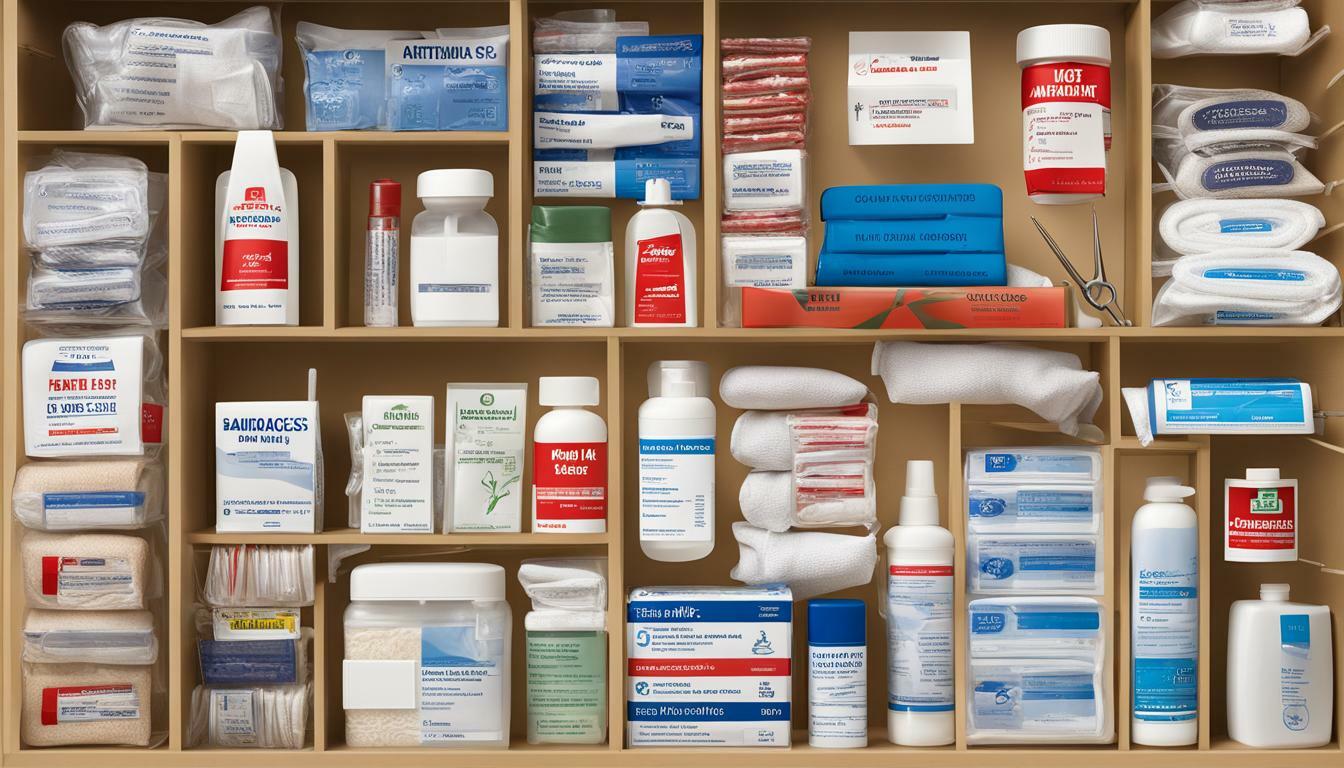
Remember, it’s always better to be over-prepared than under-prepared when it comes to first aid supplies. Take the time to assess your needs and stock your kit accordingly.
Choosing the Right Container
When it comes to storing your first aid kit, choosing the right container is key. Not only does it need to be large enough to hold all of your supplies, but it also needs to be organised in a way that makes it easy to access everything you need in an emergency.
There are plenty of ready-made first aid kits on the market, but you can also create your own DIY storage solution. Some popular options include tackle boxes, tool boxes, and even old lunch boxes. Whatever container you choose, make sure it’s durable and easy to transport if needed.
Another great storage hack is to use clear plastic bags or pouches to keep items organised within the container. These can be particularly helpful for smaller items like band-aids, gauze, and ointments. You can also label the bags to make it easy to find what you need.
One thing to keep in mind is that your first aid kit container should be easily identifiable in case of an emergency. You don’t want it getting lost or mixed up with other storage containers. Consider adding a brightly coloured sticker or ribbon to the outside of the container to make it easy to spot.

Remember, the goal of organising and storing your first aid kit is to ensure that you’re prepared for any emergency situation. By choosing the right container and using some simple storage hacks, you can create a kit that is both functional and easy to access.
Organising Your First Aid Kit
Proper organisation is key to ensuring your first aid kit is effective in an emergency situation. Here are some useful organising tips:
- Categorise items: Group your first aid supplies by their purpose. For example, keep all bandages together, all medications together, and all antiseptics together. This will make it easier to find what you need quickly.
- Use compartments or dividers: Keep your supplies organised within your first aid kit by using compartments or dividers. This will help prevent items from getting mixed up or lost.
- Maintain an inventory: Create a list of all the items in your first aid kit and update it regularly. This will help you keep track of what you have and what you need to replenish.
By organising your first aid supplies in this way, you can be confident that you are well-prepared for any emergency.

It’s also important to consider the size and shape of your container when organising your first aid kit. Choose a container that is large enough to hold all your supplies comfortably, but not so large that it becomes difficult to store or carry.
Next, consider the frequency with which you will need to access your first aid supplies. If you will be accessing your kit frequently, choose a container with easy-open compartments or pockets. If your kit will be stored for long periods of time, choose a container with a tight seal to help prevent moisture and dust from damaging your supplies.
By taking these factors into account and following these organising tips, you can ensure that your first aid kit is always well-stocked and easy to access when you need it.
Labelling and Documentation
Proper organisation of your first aid supplies involves more than just arranging them in a container. Labelling individual items can make a significant difference in an emergency situation, particularly if you have limited time. Clearly marked items will also enable others to locate and use the necessary equipment and supplies quickly.
Be sure to label all your first aid supplies clearly and legibly with their contents. It’s also useful to include expiry dates and indicate when an item has been used and needs to be replaced. You can use markers, stickers, or tape to label your items. Another option is to use colour-coded labels, which can help you distinguish between different types of items at a glance. For example, you might choose to use red labels for items related to bleeding and blue for items related to respiratory function.
In addition to labelling, it can be helpful to include documentation in your first aid kit. This might include emergency contact information, a list of medications and relevant medical conditions, or first aid guides. Having this information readily available can make a significant difference in an emergency, particularly if you are treating someone you are not familiar with.
| Organising Tip | Use a clear, waterproof pouch to store and organise your documentation, and ensure it’s easily accessible within your first aid kit. |
|---|
Remember, your first aid kit should be tailored to your individual needs, so consider which items and documentation will be most relevant to you and your family in an emergency situation.
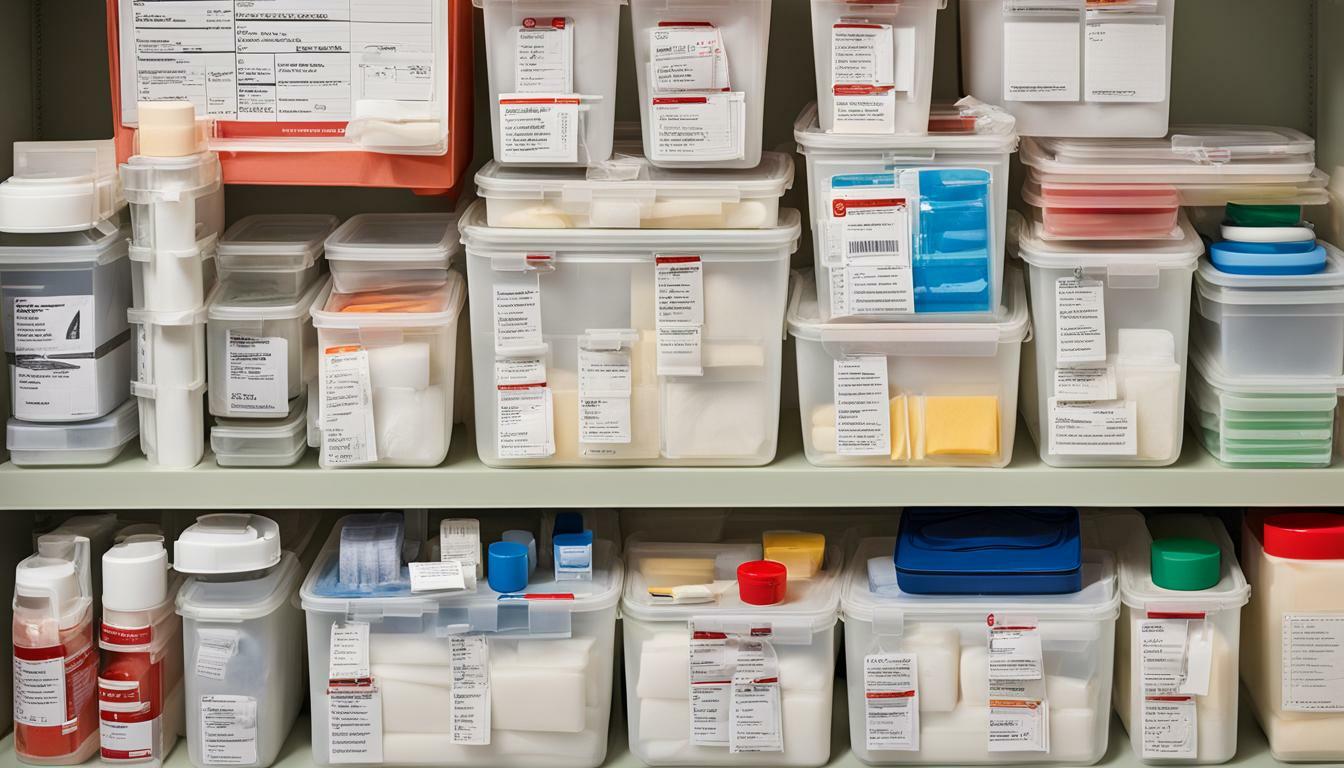
Stocking Up on First Aid Supplies
In any emergency situation, having a well-stocked first aid kit is crucial for providing immediate care. It is important to regularly check and replenish your first aid supplies to ensure that you are prepared for any unexpected situations. Here is a list of first aid kit essentials to have on hand:
- Bandages and dressings: including adhesive plasters, sterile gauze dressings, and adhesive tape.
- Cleaning and antiseptic supplies: such as sterile saline solution, antiseptic wipes, and hand sanitiser.
- Thermometer: to monitor body temperature in case of fever or hypothermia.
- Pain relief medication: such as paracetamol or ibuprofen.
- Disposable gloves: to protect against infection.
- Tweezers and scissors: useful for removing splinters and cutting dressings to size.
- Emergency blanket: to keep warm in case of hypothermia.
It is also important to consider any specific first aid needs that may be relevant to your lifestyle or location. For example, if you live in an area with a high risk of snake bites, you may need to include a snake bite kit in your first aid supplies.
Remember to regularly check the expiry dates on your first aid supplies and make sure to replace any items that have expired. It is also a good idea to periodically review and update your first aid kit to ensure that it remains up to date with your changing needs.
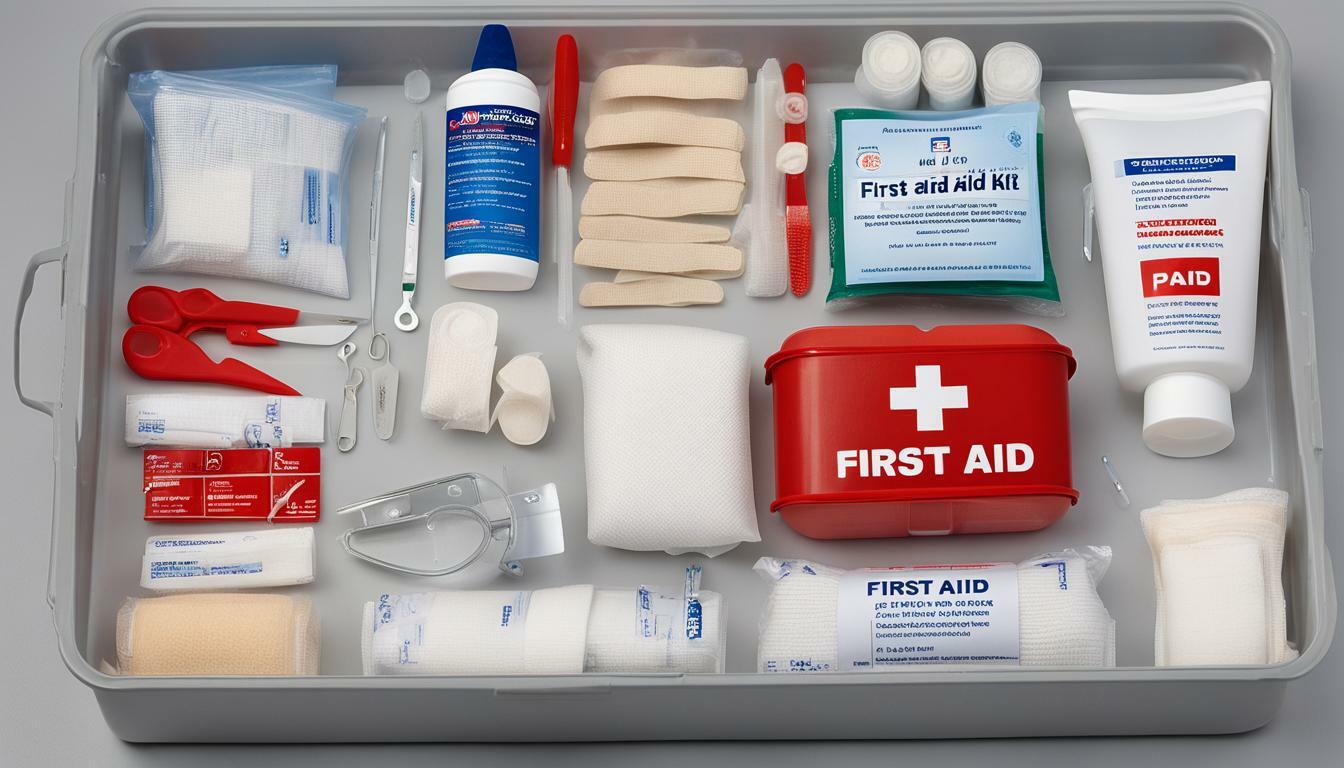
| Essential | Recommended Quantity |
|---|---|
| Adhesive plasters | Assorted sizes |
| Sterile gauze dressings | 2-3 per size |
| Adhesive tape | 1 roll |
| Absorbent compress dressings | 2-3 per size |
| Sterile eye pads | 2 |
| Triangular bandages | 2 |
| Antiseptic wipes | 10 |
| Disposable gloves | 2 pairs |
| Thermometer | 1 |
| Scissors | 1 pair |
| Tweezers | 1 pair |
| Emergency blanket | 1 |
| Pain relief medication | 1 pack |
Storing Your First Aid Kit
Now that you have organised and stocked your first aid kit, it is important to store it in a safe and accessible location. When choosing a storage area, consider the following:
- Accessibility: Ensure that the kit is easily accessible and in a visible location.
- Temperature: Store the kit in a cool and dry place, away from direct sunlight and heat sources.
- Location: Keep the kit in a central location, known to all family members, and easily accessible in case of an emergency.
- Children: Store the kit in a secure location, out of reach of young children, but still accessible for adults.
You can also use creative storage hacks such as wall-mounted cabinets or under-the-bed storage boxes to keep your kit organised and accessible.
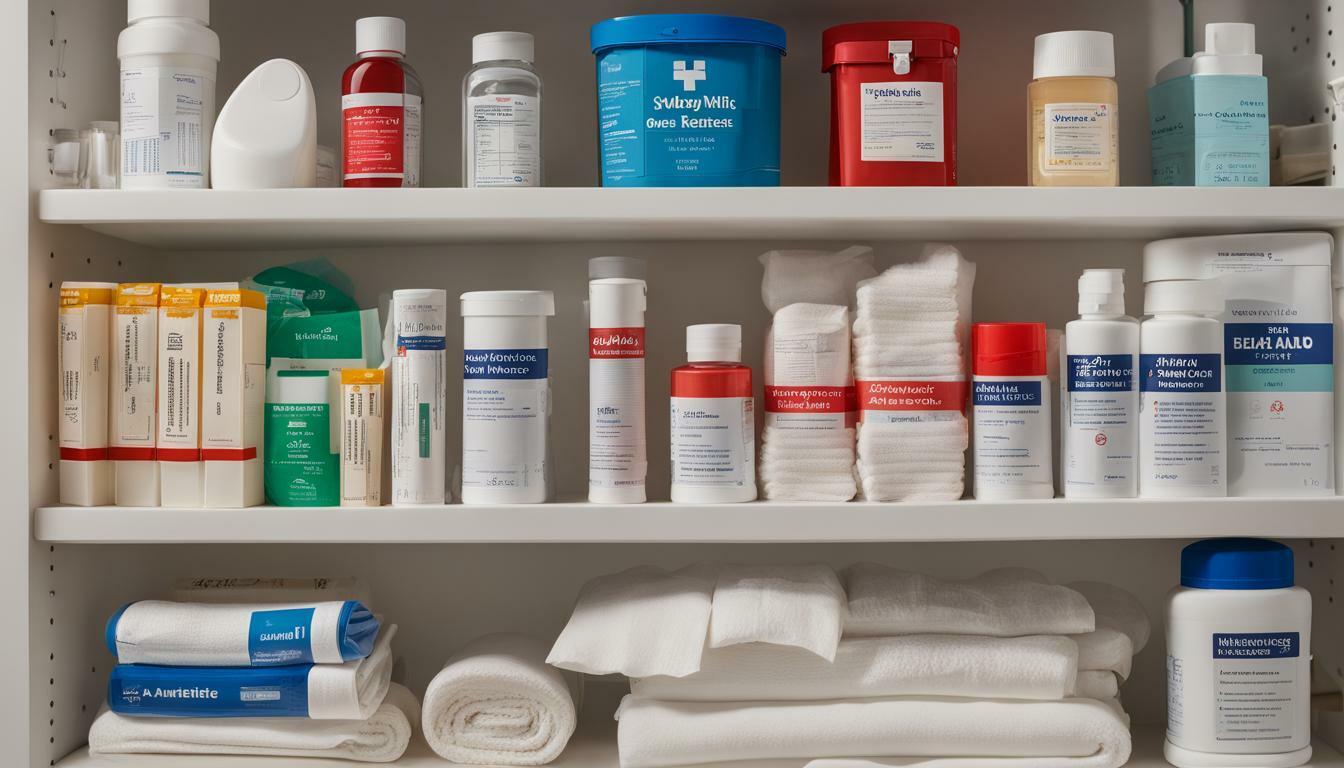
Remember to periodically check the contents of your kit and update it if necessary. By investing time in proper organisation and storage, you can ensure that your first aid kit is ready to use whenever the need arises and can help keep your home and family safe.
Taking Your First Aid Kit On the Go
Having a first aid kit that is portable and easy to access can be essential in emergency situations. Whether you are travelling, hiking, or engaging in any outdoor activities, having first aid supplies at hand can provide peace of mind and potentially save lives.
When choosing a portable first aid kit, it is important to consider the specific needs of your activity and the potential risks involved. For example, a kit for hiking should include items such as insect repellent and blister pads, while a kit for boating should include supplies for treating burns and water-related injuries.
In addition to tailoring the contents of your kit, it is also important to pack it in a way that is organised and easily accessible. Using a waterproof container or bag can help protect the supplies from damage and keep them dry. It is also helpful to label the contents of the kit and include a first aid guide or instructions for use.
Some essential items to include in a portable first aid kit include:
- Adhesive bandages of various sizes
- Gauze pads and adhesive tape
- Antiseptic wipes and ointment
- Pain relievers and fever reducers
- Allergy medication and epi-pens, if needed
- Tweezers and scissors
- Emergency blanket
- Whistle and signal mirror
It is also important to periodically check and restock your portable first aid kit, especially after each use or at the beginning of a new season or activity. This will ensure that you are prepared for any emergency situation that may arise.
With the right first aid equipment and supplies, you can be confident and prepared for any situation, no matter where you are or what you are doing.
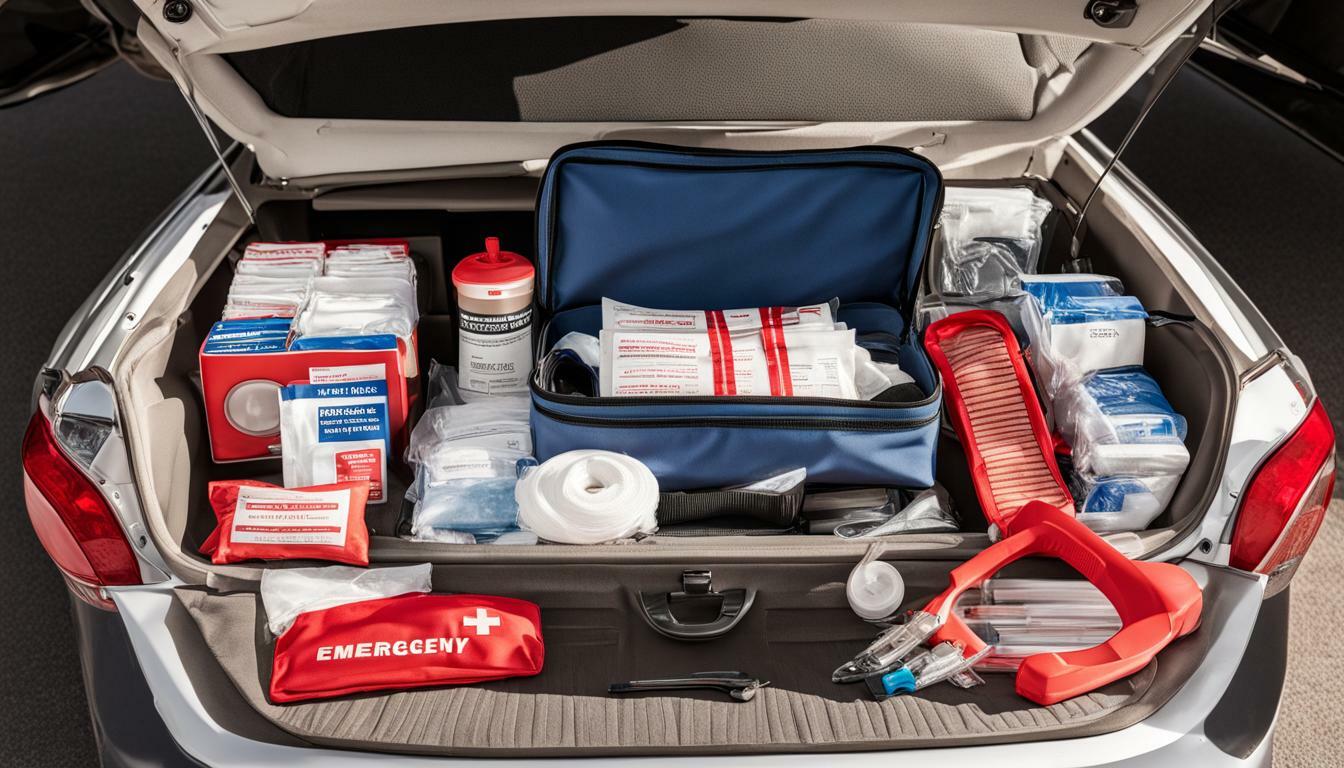
Periodic Maintenance and Upgrades
Keeping your first aid kit organized and well-stocked is crucial for emergency preparedness. However, it’s equally important to conduct periodic maintenance and upgrades to ensure that your kit remains effective and up-to-date.
Regularly review the supplies in your kit and check expiration dates. Replace any expired items and restock any supplies that are running low. Consider adding new items that may be relevant to your specific needs or activities.
Staying informed about new developments in first aid procedures and equipment can also help you maintain an effective kit. Attend first aid classes or workshops, read relevant literature, and stay up-to-date with any changes in recommended practices.
Organizing your kit in a logical and consistent manner can also make periodic maintenance easier. Keep a running inventory of your supplies and store them in clearly labeled compartments or containers. This can help you quickly identify any missing or expired items, making it easier to restock and refresh your kit.
Remember, a well-maintained and organized first aid kit can make all the difference in an emergency situation. By taking the time to conduct periodic maintenance and upgrades, you can ensure that your kit is always ready to use when you need it most.

Conclusion
Organising and storing a first aid kit properly is crucial for emergency preparedness and home safety. This comprehensive in-depth guide has provided practical tips and advice for ensuring that your kit and its contents are tailored to your individual needs and are easily accessible when needed.
Remember to regularly review and update your kit, keeping track of expiry dates and replacing items as necessary. It is also important to consider portable first aid kits for situations where a full kit may not be practical.
We hope that this guide has been informative and useful in helping you prepare for any emergencies that may arise. Stay safe and stay prepared!
